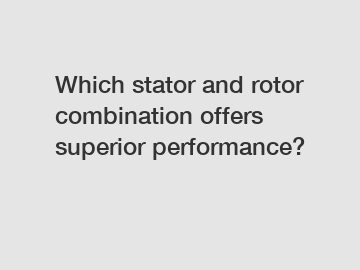Which stator and rotor combination offers superior performance?
Which Stator and Rotor Combination Offers Superior Performance?
When it comes to electric motors, the stator and rotor combination plays a critical role in determining the performance and efficiency of the motor. A properly designed stator and rotor combination can significantly enhance the motor's performance, while a subpar combination can lead to reduced efficiency and reliability. In this blog post, we will explore different stator and rotor combinations and analyze which ones offer superior performance.
Before we delve into specifics, it is essential to understand the basics of stators and rotors. The stator is the stationary part of the motor, consisting of coils wound around an iron core. It produces a rotating magnetic field when energized, which interacts with the rotor to generate torque. On the other hand, the rotor is the rotating part of the motor, usually made of laminated iron cores with conductive windings.

The first stator and rotor combination that deserves our attention is the squirrel cage rotor with a distributed winding stator. The squirrel cage rotor is a common choice due to its simplicity and high efficiency. It consists of conducting bars embedded in the rotor's laminated iron cores. This combination provides excellent starting torque and is highly reliable. However, its speed control capabilities are limited, making it less suitable for applications that require precise speed control.
For applications that demand a higher level of speed control, the wound rotor with distributed winding stator is a preferred choice. The wound rotor contains windings on the rotor similar to the stator but with external connections. This allows for external resistance to be added, enabling precise torque and speed control. The wound rotor offers better performance in applications such as cranes or elevators, where precise speed control is crucial. However, it is more complex and costly compared to the squirrel cage rotor.
Another stator and rotor combination worth considering is the permanent magnet rotor with a concentrated winding stator. Permanent magnets are integrated into the rotor, eliminating the need for winding on the rotor and simplifying the motor structure. This combination provides excellent power-to-weight ratio, higher efficiency, and better control performance compared to squirrel cage and wound rotor designs. It is widely used in applications such as electric vehicles and robotics, where weight and energy efficiency are critical factors.
In recent years, the interior permanent magnet (IPM) rotor with a distributed winding stator has gained popularity due to its superior performance. The IPM rotor incorporates permanent magnets in the rotor structure, similar to the permanent magnet rotor. However, it also features salient poles on the rotor surface, providing stronger magnetic interactions with the stator. This design allows for better control of torque, improved efficiency, and higher power density, making it ideal for high-performance applications like industrial machinery and hybrid electric vehicles.
While each stator and rotor combination has its strengths, the choice ultimately depends on the specific requirements of the application. It is crucial to consider factors such as speed control, starting torque, energy efficiency, and cost-effectiveness when selecting a stator and rotor combination. Additionally, technological advancements and innovative designs continue to emerge, offering new possibilities for motor performance enhancement.
In conclusion, the performance of an electric motor greatly depends on the stator and rotor combination. Different combinations offer varying degrees of performance, efficiency, and control capabilities. The squirrel cage rotor, wound rotor, permanent magnet rotor, and interior permanent magnet rotor each have their advantages and suitability for specific applications. To achieve superior motor performance, it is essential to carefully analyze the requirements and select the most appropriate stator and rotor combination. As technology progresses, we can expect further advancements in motor design that will unlock even higher levels of performance and efficiency.
Are you interested in learning more about welding lamination, Sub-assembly production, stators for bldc motors? Contact us today to secure an expert consultation!


